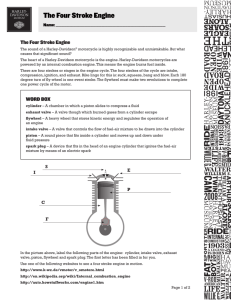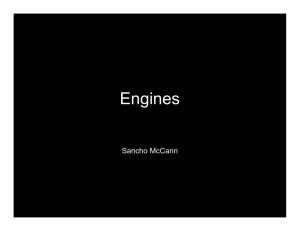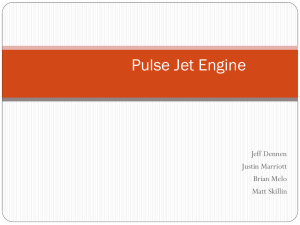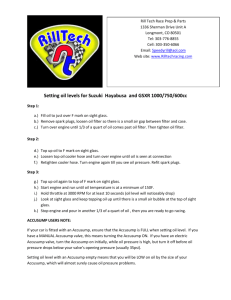View Document - American Power Boat Association
advertisement
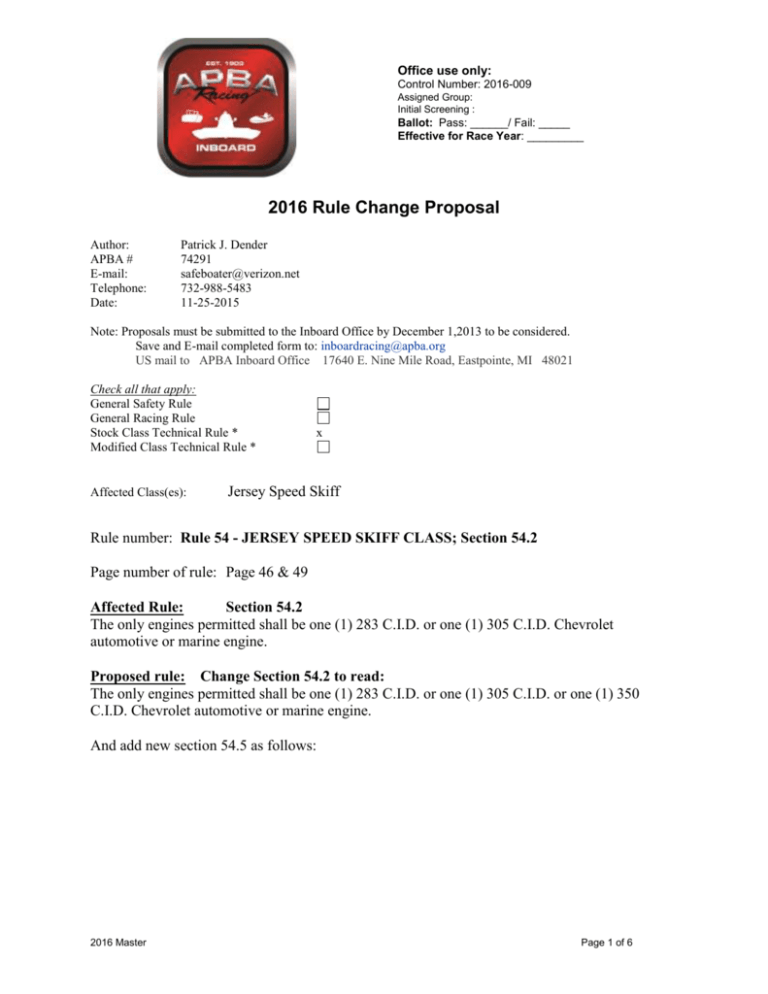
Office use only: Control Number: 2016-009 Assigned Group: Initial Screening : Ballot: Pass: ______/ Fail: _____ Effective for Race Year: _________ 2016 Rule Change Proposal Author: APBA # E-mail: Telephone: Date: Patrick J. Dender 74291 safeboater@verizon.net 732-988-5483 11-25-2015 Note: Proposals must be submitted to the Inboard Office by December 1,2013 to be considered. Save and E-mail completed form to: inboardracing@apba.org US mail to APBA Inboard Office 17640 E. Nine Mile Road, Eastpointe, MI 48021 Check all that apply: General Safety Rule General Racing Rule Stock Class Technical Rule * Modified Class Technical Rule * Affected Class(es): x Jersey Speed Skiff Rule number: Rule 54 - JERSEY SPEED SKIFF CLASS; Section 54.2 Page number of rule: Page 46 & 49 Affected Rule: Section 54.2 The only engines permitted shall be one (1) 283 C.I.D. or one (1) 305 C.I.D. Chevrolet automotive or marine engine. Proposed rule: Change Section 54.2 to read: The only engines permitted shall be one (1) 283 C.I.D. or one (1) 305 C.I.D. or one (1) 350 C.I.D. Chevrolet automotive or marine engine. And add new section 54.5 as follows: 2016 Master Page 1 of 6 54.5 350 C.I.D Engine - All parts inside the engine must remain completely stock as furnished by the original engine manufacturer except as follows: 54.5.1 Block - Block: Stock cast iron production GM V-8 style block with standard external measurements only, no V-6 or 4 cylinder blocks allowed. Identification numbers may not be removed. 54.5.1.1 Aftermarket Block- The only aftermarket engine block permitted is Dart SHP P/N: 31161111. No grinding or lighting allowed. Maximum cylinder overbore allowed is (0.040”). A maximum of three cylinder bores and/or a maximum of seven lifter bores may be sleeved. (No indexing lifter bores) Motor mounts/supports may be used. Crankcase breathers may vent the engine in any “Nonmechanical” manner. Valley trays under the intake manifold are permitted. 54.5.2 Oil Pan - Any oil pan, mechanical oil pump driven off the distributor and pickup may be modified in any manner provided the engine remains a wet sump system and that all oil lines and hoses remain inside the pan. The oil pan shall mean from the mounting surface of the block for the pan, down. There must not be any modifications to the main bearing caps for attaching of windage trays, etc., other than extended studs. 54.5.3 Crankshaft - Steel magnetic crankshafts only, minimum weight: 50 lbs. including balancing. Unaltered in any way except for normal cleanup and balancing. May not be contoured or sculptured. Stock aftermarket “as cast” (over the counter) “knife edge” from major manufacturer is allowed. No modifications after purchase allowed. Stroke: 3.480” ±0.010”. Stock main journal (2.4450”) and rod journal (2.100”) sizes only (undercut maximum: 0.030”). 54.5.4 Pistons - Any piston may be used. Pistons must remain in stock configuration. Piston skirt must be a full round. No FSR style pistons. No portion of the piston may protrude above the top of the block (measurement excludes head gaskets) and a combined deck height .057” measured with compressed head gasket is required. No gas porting of piston rings, ring glands and no top of piston coating of any kind. Ring lands must remain in standard location. Minimum distance between top of piston and top of first ring (compression): 0.180”. The weight of each piston should not be less than 590 grams including the wrist pin, pin clips and rings. Maximum size over standard piston allowed is (0.030”). 54.5.4.1 Piston Rings: Must be of the type supplied by General Motors. The 1st and 2nd rings (compression) must be 1 piece design, 3rd ring (oil) must be 3 pieces design, consisting of 2 rails and 1 expander. Moly file fit rings allowed. Minimum thickness of rings 1/16” for top and second, 3/16” for oil control ring. No gapless rings allowed. 54.5.5 Connecting Rods - Any large journal magnetic steel type connecting rods only. Maximum length: 5.700” ± 0.010”. Minimum weight: 600 grams including cap, bolts, and/or nuts. Must use full floating pins. No titanium or aluminum rods. 54.5.6 Camshaft - Any aftermarket cam manufacture may be used providing it meets the OEM profile under these class rules for GM part #3736097 or #3736098. Stock or stock replacement solid valve lifters are permitted. Only stock or roller type timing chain and gears are permitted. It shall be permissible to advance or retard the camshaft from its stock position. NO machining other than for the indexing of the camshaft alignment pin and for the mounting bolts is permitted on the timing gears. 2016 Master Page 2 of 6 54.5.7 Cylinder Heads - All cylinder heads must be either GM casting # 333882 or 3932141. The minimum combustion chamber volume shall be 64cc per chamber. The intake and exhaust passages, as well as the combustion chamber, shall not be ground, polished or enlarged by any means. The intake Port Volume will be 165cc +2/- 5cc, The Exhaust Port Volume: 65cc +2/5cc. 54.5.7.1 Aftermarket Cylinder Heads; The only allowable head for use is Dart Part #:10021070 Dart Iron Eagle S/S 165 and must have the official APBA or ACHA stamp on at all times. Combustion chamber, intake and exhaust ports must be in the original ‘as cast’ configuration. Minimum volume of the combustion chamber: 64 cc. Head intake runner volume: 175cc (± 2cc). Head exhaust runner volume: 65 cc. (± 2cc). New purchase must be done through the APBA Inboard office (586) 773-9700 All heads must remain unaltered in any way except for flat milling of deck. Cylinder heads may be machined for valves seals, screw-in or pinned rocker arm studs, for marine conversions and on contacting surfaces for the attachment to the block. Use of head gaskets is mandatory. No change is permitted in the valve area, angle of valve seat and the valves will remain in stock shape and size. Three angle valve seats are permitted in the head as follows: 1 approach; 1 seat; 1 bottoming. No angle is to be wider than .125". Valve seat width and no seat shall be less than .062" (to remove trick valve jobs and promote longer valve seat life). The rocker arm ratio is to remain 1.5 to 1. Valves must be stock Chevrolet, GM, or any OEM type valve (stainless permitted). The intake valve diameter shall be 1.94" and exhaust 1.50" with minimum 11/32" or 0.340” Stem size throughout its length. Swirl polished valves are permitted. Shims and any single winding 1.250” OD sized valve spring and dampener is permitted. Rocker arms, rocker balls, pushrods, retainers, and keepers must be stock Chevrolet or steel replacement parts sold over the counter for the automotive trade. Roller rockers may be used provided they maintain the stock rocker ratio (1.5:1) and a single stud type mounting configuration no larger than 7/16”. The use of poly-locks and guide plates is permitted (No angle milling allowed). Machining outer edge of valve guide for smaller valve seals and bronze liner allowed. Valves must be in stock location and at stock angle. No gasket matching. Any evidence of sanding, polishing, relieving, grinding, porting, chemical treating, ceramic work, abrasive blasting, and alteration of the original form or the addition of material to the ports or combustion chambers are prohibited. . . Only log type, aluminum, water cooled exhaust manifolds can be used and all gases and water must be mixed no farther than eight inches (8”) from the exhaust manifold outlet and must pass through the transom. 54.5.8 Intake Manifold- must be an aluminum Edelbrock Torker II part #P/N5001 (for small block Chevrolet). The dimensions of the runners shall be 1.100 by 1.75 inches maximum at the cylinder head gasket face and .925 inches by 2.500 inches maximum adjacent to the plenum area. No grinding, polishing, or enlargement of the inlet or outlet ports or runner areas is permitted. Milling or changes to the shape for the attachment of the carburetor or adapter/wedge is not allowed. Blocking off the heat and water passages is permitted in the intake manifold or with gaskets only. Machining for a steam vent in the intake manifold’s normally casted closed rear water plate that leads directly to the head shall be permissible. A carburetor wedge or adapter to compensate for the engine angle may be used only if the total overall height does not exceed three (3) inches. This includes any gaskets or throttle linkage plates mounted between the intake manifold and the carburetor. The intake manifold must not be painted, dyed, anodized or in any other way finished. 2016 Master Page 3 of 6 54.5.9 Carburetor - The carburetor shall be limited to one (1) mass production American make, having no more than four (4) venturis. The throttle plate shall have holes no larger than 1.750 inches in diameter. Any type air scoop or velocity stack may be used provided the air intake opening does not face forward. This condition pertains to whether the device is attached to the carburetor or engine hatch cover. No forward facing air deflectors allowed for air intake. Any fuel filter and mechanical or electrical fuel pump, with or without regulator may be used. (Fuel— see General Technical 40.18.12). 54.5.10 Distributor - Any electric or single fire distributor that fits the 283/305 C.I.D. Chevrolet engine without adaptation is permitted. Magneto or crank triggered ignition, multispark discharge ignitions or remote controlled ignitions systems from inside the cockpit are prohibited. Tach drive distributors are permitted. Removal of the vacuum advance, altering the mechanical advance curve and fastening of the breaker plate, shall be allowed. Spark plugs, plug wires, distributor cap and ignition coil must be an OEM or stock replacement parts on the open market. Any single fire discharge ignition may be used as an alternate ignition providing it is operated on 12 volts. 54.5.11 Cool Cans- All devices to cool and reduce fuel temperature are strictly prohibited. 2016 Master Page 4 of 6 54.5.12 Inspections - In the event that a new record is established, the entire engine must be completely dismantled to determine stock status and 6 point minimum inspection for the hull. At any race other than the Nationals and/or Divisionals, the race committee can have any boat or any number of boats inspected and may use the 7 point inspection procedure for the engine and the 6 point inspection procedure for the hull. Not to preclude a more detailed inspection for both. 54.5.13 Jersey Speed Skiff Inspection Procedure, 350 CID. Chevy engine: This procedure will speed up inspections at the race site. Equipment needed for Inspectors: One 6” or 8” degree wheel attached to a distributor rotor. One dial indicator with 0.500” travel. One 4”x4”x3/16” steel plate with hole to attach to head bolt. One piece of wire for pointer. 54.5.14 Procedure to be used for Jersey Speed Skiff Camshaft: Rotate engine in normal direction until the lifter is on the heel of the camshaft lobe. Set dial indicator on valve spring retainer. Preload dial indicator and set dial indicator back to zero. Adjust valve lash until dial indicator reads 0.001. Set dial back to zero. Rotate engine in normal direction until dial indicator reads 0.050 on the opening ramp. Set pointer to zero on degree wheel and start procedure as listed. Camshaft: GM part #3736097 or #3736098 Exhaust Lobe Intake Lobe Lift Degrees Lift Degrees .050 0 .050 0 .100 8 .100 7 .200 19 .200 18 .300 32 .300 31 .400 62 .394 61 .300 92 .300 88 .200 105 .200 101 .100 116 .100 112 .050 122 .050 118 Maximum lift of exhaust valve must not exceed 0.400 with zero lash Maximum lift of intake valve must not exceed 0.396 with zero lash 54.5.15 7 Point Minimum Inspection Procedure for 350 cu. in. engine (Not to preclude single item inspection or a more detailed inspection to include minimum weight requirements). • Carburetor throttle plate max size 1.750 • Distributor, See Rule 2(j) or 3(j) • Intake manifold and cylinder heads must not be polished or ground. • Cylinder head volume 64cc min. and a combined deck height .057” measured with compressed head gaskets. • Valve sizes: Intake 1.94" / Exhaust 1.50 each with straight 11/32" stem size • Bore 4.035 max. - Stroke 3.48 • Profile camshaft to GM part #3736097 or #3736098 2016 Master Page 5 of 6 Reason for change: To provide a foreseeable long term engine option to the Jersey Speed Skiff Class, while providing an Entry Level “Low Cost” Alternative power plant for immediate relief to smaller teams and new competitors. It is not the intention of this rule to displace the present legal engine rules (and thereby increasing costs), but to allow a low cost option for smaller teams and new competitors to participate in our class, while providing a time proof platform to operate around for the long term. Presently nearly all parts specific for the 283 & 305 are no longer available or increasingly hard to find, each requiring special BULK special orders for the manufactures to produce and are not realistic for our members acting alone or on a budget. This Rule Change proposal will bring the JSS Skiff class to a more current engine platform, with all parts readily available from nearly every vendor. These changes are highly restrictive by DESIGN and will help limit the incentive to push the “gray” areas, that are not always practiced within the present 283/305 engine rules. The inspection process will be conducted in the same normal steps now performed for the JSS class, and for commonality with other classes, has identical minimum weights and measurement’s found within the E-350 hydro class rules. The only difference in the E-350 engine platform and this rule proposal is the 097 Cam and the Torque II intake manifold. Both were carried over to help reduce swap over cost, while keeping performance ratings slightly below present 283/305 specs. Further equalization in performance (relative to the 283/305 engines) should be increased easily by normal rule proposals in the foreseeable future, with simple additions of cam lift and/or duration, and should only be considered (to prevent the present engines form becoming irrelevant) after a 3-5 year exposure within the class and It should be noted that a majority of the recreational and racing skiffs operating outside APBA are nearly all SBC-350 powered, and most have shown acceptable long term operational serviceability, with performance slightly below our present APBA operating speeds. This rule also falls very close in similarity to the 350 rules found in (2) outside JSS sanctioning bodies located in NJ, and with minor changes, these boats would be a source for expanded competition and growth within the class and an increase in overall APBA membership. 2016 Master Page 6 of 6
